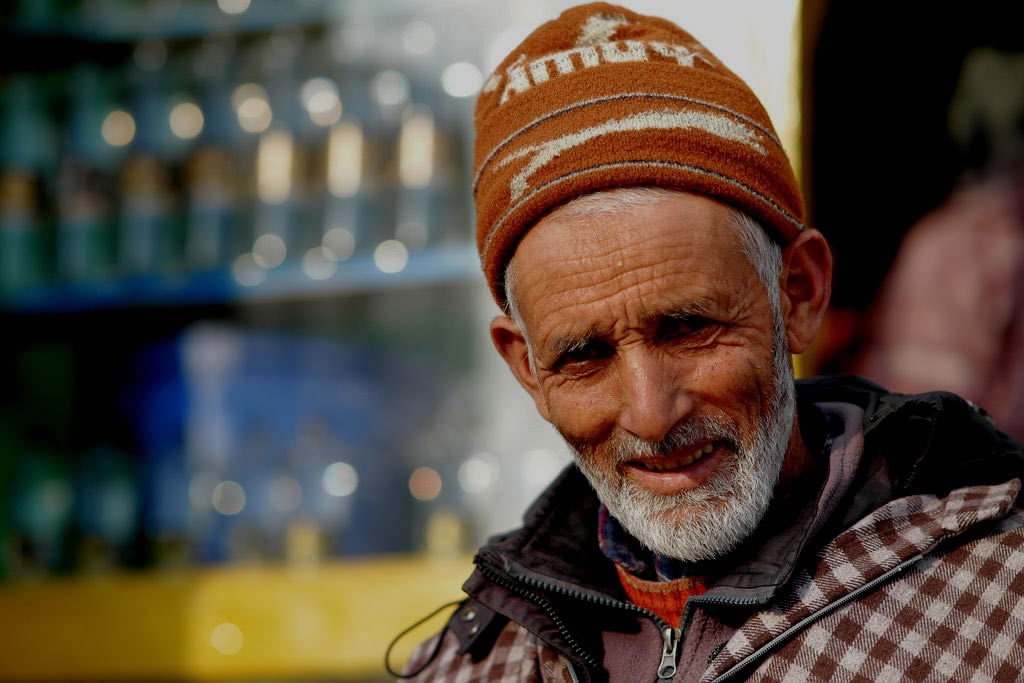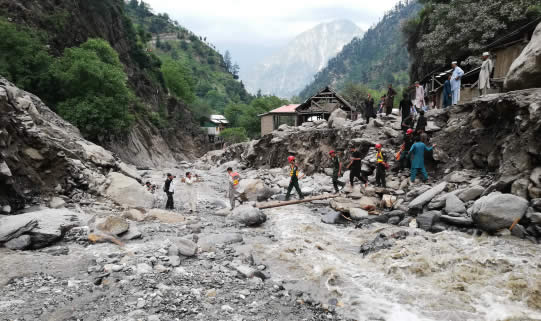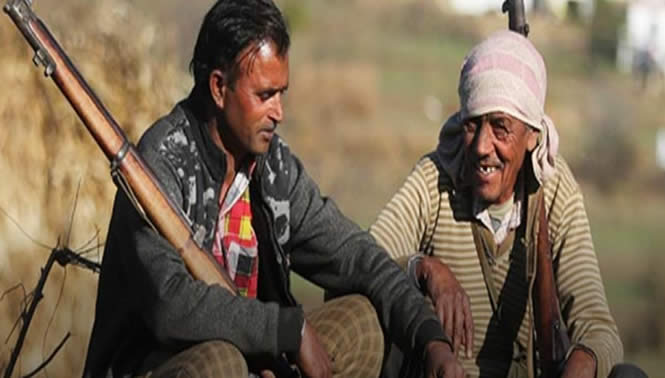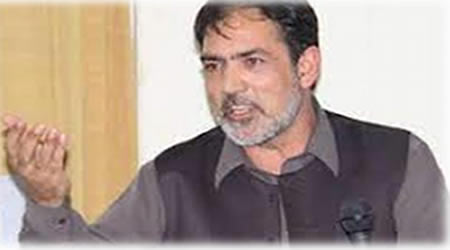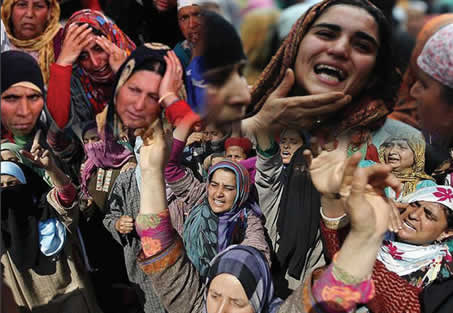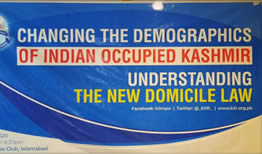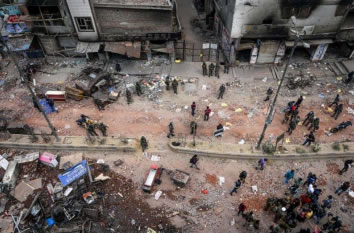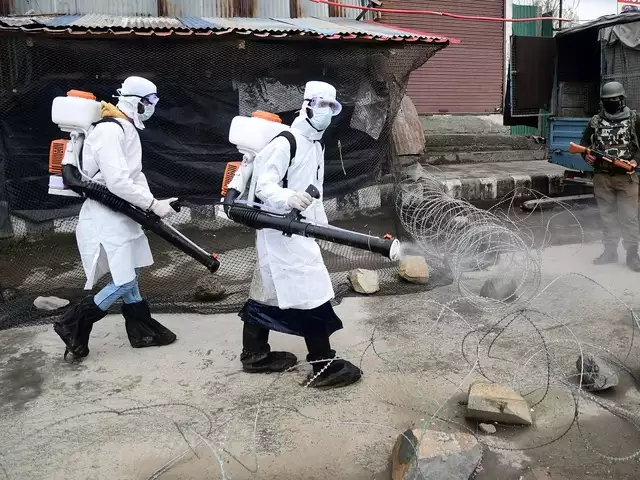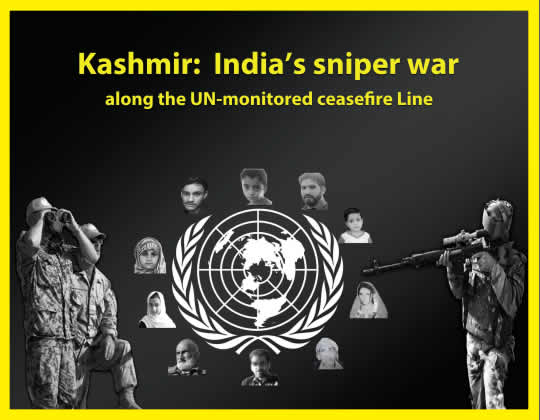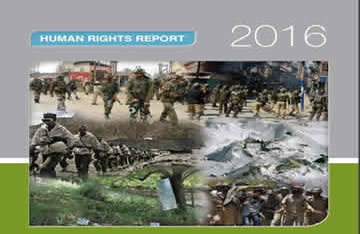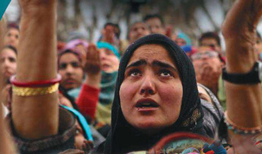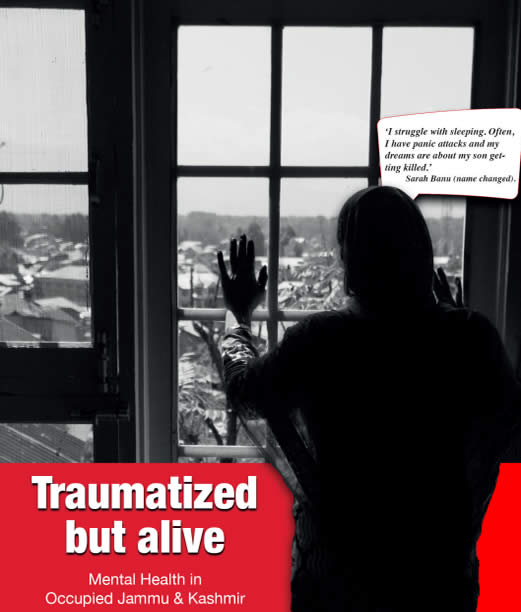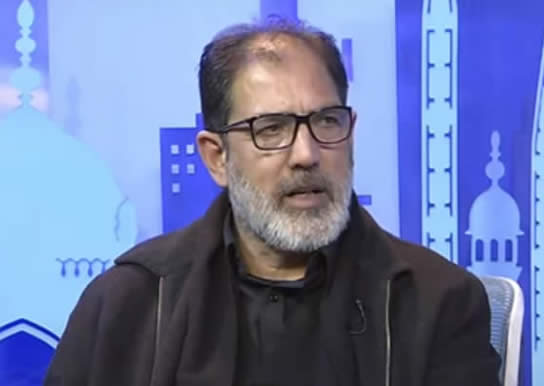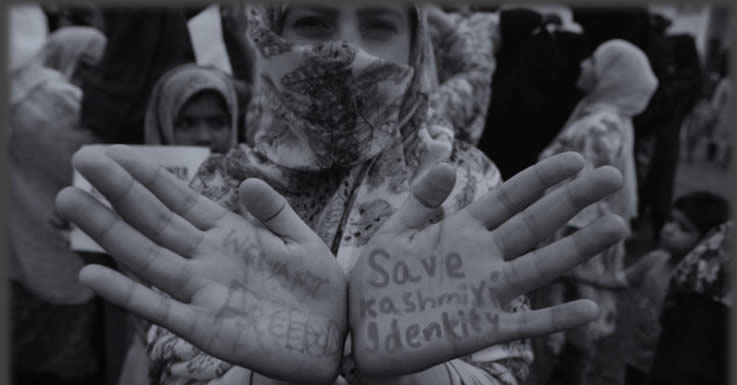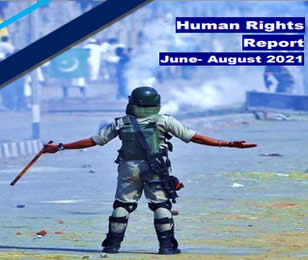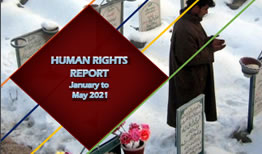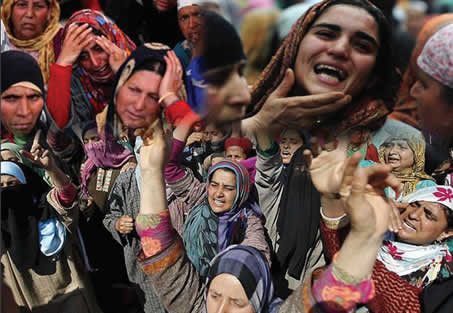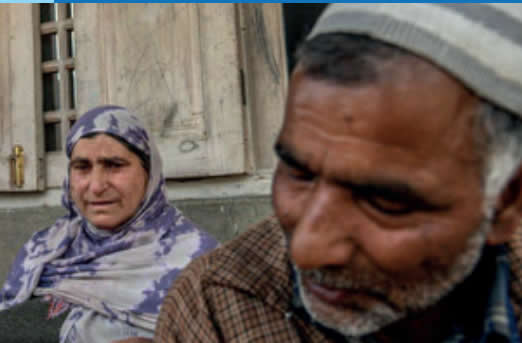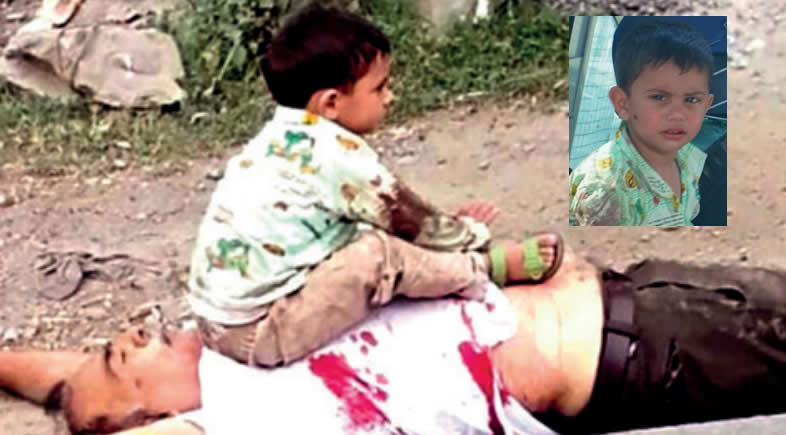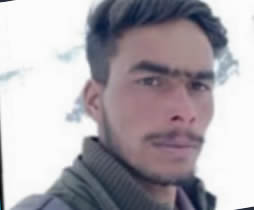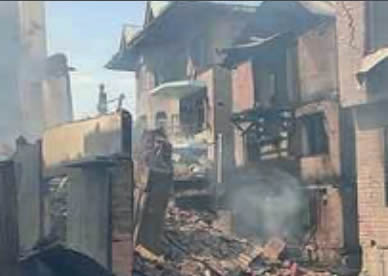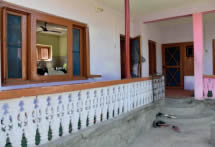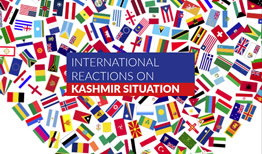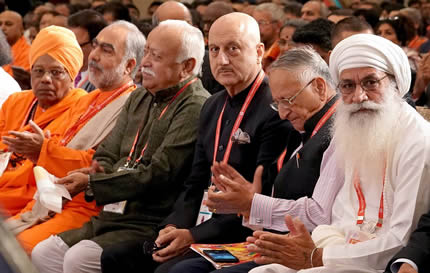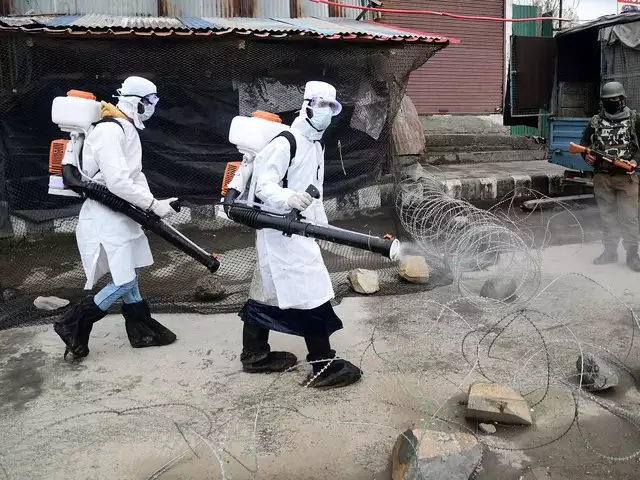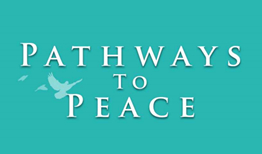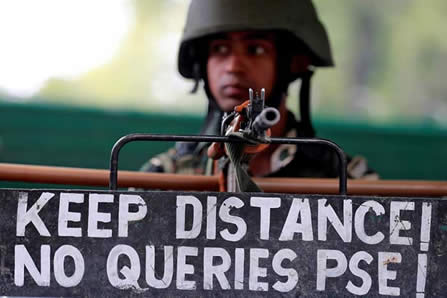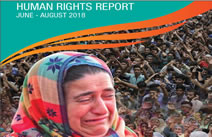HUMMAN RIGHTS REPORT
Introduction
The Supreme Court’s recent judgment by SC’s five-judge Constitution bench on December 11, 23, acknowledging asymmetric federalism as a component of the Indian federal structure, raises important issues. Notwithstanding this recognition, the verdict falls short in addressing pivotal concerns related to sovereignty, parliamentary powers, and trajectory of statehood. The Indian government’s assertion that sovereignty was relinquished in 1947 warrants a more comprehensive exploration of historical context, particularly in the context of validating the revocation of Article 370. Importantly, the judgment’s impact on international dimensions, notably the United Nations Security Council resolutions on Kashmir, remains contentious. The Indian Supreme Court’s validation of Article 370’s revocation cannot supersede these resolutions, raising questions about judicial impartiality and potential biases. Despite India’s attempts to change the status of Indian Illegally Occupied Jammu & Kashmir, international recognition and the validity of UN resolutions, especially Resolution 47, remain unchanged.
This resolution explicitly urges India to conduct a plebiscite promptly on the question of Jammu & Kashmir’s accession to India or Pakistan. Consequently, the enduring significance of international resolutions, notably Resolution 47, is underscored in fortifying the cases for both Pakistan and the Kashmiri populace. Four years post the revocation of Jammu and Kashmir’s constitutional status on August 5, 2019, the region remains ensnared in a disconcerting state of flux, marking the end of a seven-decade-long special status under Article 370 and stripping away fundamental human rights as the Modi administration charted a new course. Despite India’s assertions of ‘normalcy,’ the reality on the ground paints a starkly different picture—one characterized by suppressed, political, and economic life, perpetuated insecurity, and state-driven violence. Amid the touted normalcy, Kashmiris grapple with an unrelenting war, where chaos and uncertainty prevail. Violence and bloodshed persist unabated, underscoring a disconcerting lack of progress toward peace. Human rights abuses continue, fundamental freedoms are suspended, and an overarching sense of fear and insecurity shrouds the region.
The suppression of freedom of speech and expression has led to the mass incarceration of thousands of Kashmiris, languishing as undertrials in distant jails. Simultaneously, a multi-front onslaught, involving the erosion of identity, poses a substantial challenge since the abrogation of Articles 370 and 35A. The government of India, through the modification of age-old laws and the introduction of hundreds of new ones, propels a settler colonialism campaign, aiming to erase Kashmir’s political, religious, and cultural identity. Human rights groups operating in the region consistently depict a grim reality, highlighting the catastrophic conditions prevailing in Kashmir. However, their concerns and recommendations, replete with substantiated facts, remain largely unheeded on the global stage. Regrettably, New Delhi, seemingly preoccupied with projecting an image of normalcy, neglects the imperative of upholding rights and ensuring accountability. The Modi regime’s actions stand in clear defiance of fundamental human rights and humanitarian principles, disregarding not only the thirteen United Nations Security Council resolutions on Jammu & Kashmir, but also the very essence of international consensus.
Economic Realities
The economic narrative of Indian occupied Kashmir, as depicted in the Economic Survey for 2022-2023, unravels a tale of stark contradictions that challenge the rosy narratives propagated by the government. Despite official claims of growth and prosperity, the reality on the ground paints a less optimistic picture, marked by a decline in the region’s economy and a notable reduction in investments. Key economic indicators, such as per capita income (PCI) at constant prices, lay bare the glaring disparities between Jammu and Kashmir and the national average. The report exposes a significant lag in the region’s PCI, trailing behind the national figure by nearly 31,000 rupees (US$376). This glaring contrast serves as a poignant reminder of the economic challenges persisting in the region, undermining the government’s assertions of robust economic growth.
While the government touts a reported decline in the unemployment rate in Jammu and Kashmir, the devil lies in the details. The growth rate of Jammu and Kashmir’s PCI, standing at a mere 13.9, is a feeble testament to the region’s struggle for economic parity, especially when juxtaposed with the national growth rate of 15.8. These figures underscore the government’s failure to address the substantial economic disparities that plague the region. A closer look at the data reveals a bleak future for college graduates in Jammu and Kashmir. The projection of 199, 872 unemployed college graduates by May 31, 2023, paints a grim picture of the disconnect between educational achievements and employment opportunities.
This projection highlights the inadequacies in the government’s economic policies, which fail to provide meaningful avenues for the educated youth in the region. The larger context, as illuminated by the report, is the staggering total number of unemployed youth in Jammu and Kashmir, reaching an alarming 563,984. This figure lays bare the inadequacy of the government’s approach in tackling the pressing issue of unemployment, particularly among the youth, raising serious questions about the efficacy of existing economic policies. In April 2021, the local government in Indian- administered Kashmir established a special task force to review cases of employees suspected of engaging in activities warranting action under Article 311. Since 2019, over 50 government employees in the region have been dismissed based on unclear allegations of posing a «threat» to state security, facilitated by a legal provision allowing terminations without providing an explanation.
Out of the 66 senior bureaucrats serving in Kashmir, 38 are from other Indian states, and non-local individuals hold key positions in central government institutions. Fast forward to December 2023, the government has once again terminated the services of four employees, including Dr. Nisar-ul-Hassan, President of the Doctors Association of Kashmir, raising concerns about the use of vague constitutional clauses to silence dissent and prompting a call for a reevaluation of termination procedures to ensure transparency and uphold constitutional principles. In navigating the economic realities of Jammu and Kashmir, it becomes evident that the government’s claims of prosperity are hollow in the face of tangible economic challenges.
Surge of Hindu Village Defense
Committees in Kashmir On March 8, 2023, The New York Times published a revelatory article shedding light on a disconcerting development in one of the most militarized regions on Earth. The report discusses India’s controversial decision to arm villagers through the revival of civil militias known as Village Defense Committees (VDCs). This move however, has sparked widespread concern given the notorious track record of the VDCs, notorious for their past human rights abuses. Despite a grim history, the revival of these militias raises questions about accountability, as the VDCs had never been held responsible for the crimes committed against innocent people. The VDCs, primarily composed of Hindu village youths, were initially formed around 2000 and have now expanded to 5000, with the objective of suppressing the ongoing resistance movement in Kashmir. However, a decade ago, the militias were disbanded due to their involvement in a litany of offenses, including harassment Sep-Dec 23 Kashmir Institute of International Relations of Muslim populations, extortion, smuggling, and other crimes.
The alarming resurgence of these groups prompts a critical examination of the implications for human rights and regional stability. It is noteworthy that the police have registered 221 cases against VDCs for blatant violations of human rights, underscoring the gravity of their actions. The New York Times article serves as a stark reminder of the complex dynamics at play in the conflict-ridden region, where historical grievances intersect with contemporary decisions, shaping the trajectory of peace and stability. The concerns raised by the report call for a nuanced understanding of the delicate balance between security measures and the imperative to safeguard human rights, urging stakeholders to address the potential ramifications of arming villagers in a region marked by decades of unrest.
Land Grabbing
In a series of administrative decisions, amendments to the Control of Building Operations Act, 1988, and the J&K Development Act, 1970 have been greenlit by the Jammu and Kashmir administration. However, a noteworthy and concerning development is the approval to designate over a thousand kanals of land in Gulmarg and 354 kanals in Sonamarg as «strategic areas.» This expansive land, comprising 178,005.213 acres in Kashmir and 25,159.56 acres in Jammu, was acquired by Indian authorities without any prior notice to the rightful owners. Adding to the complexity, the Revenue department’s extensive list of ‘State land’ reveals that land primarily owned by Kashmiris under various Acts and orders passed by the previous state government is now in question due to the recent administrative moves. Of particular concern is a housing program aimed at providing 5 marlas of land (0.031 acres) and constructing 199,550 houses for the landless under a central initiative. However, skepticism arises due to a significant discrepancy between the reported number of landless individuals and the allocated housing units.
The official figures indicate 19,047 landless people in the region in 2021, prompting questions about the intended beneficiaries and the sudden increase in the local population by 997,750 people if each household assumes five members. Residents fear that this housing initiative may inadvertently pave the way for a large number of non-residents to gain domicile rights under the Domicile Act of 2020, which permits those who have lived in Jammu and Kashmir for 15 years or studied there for seven years to apply for a domicile certificate, thereby becoming eligible for land and jobs. Furthermore, the abrupt introduction of the 2022 land grant rules by the Jammu and Kashmir administration, replacing the 1960 land grant rules, has left residents shocked. The former policy, with a liberal lease period of 99 years extendable further, had significant implications for businesses, including 2,000 small businesses in Srinagar and all hotels in Gulmarg, which were operating under these lease terms.
As the Union Territory experiences a surge in investments from both Indian and multinational corporations, with a notable increase from 310 entities in the 2020-2021 financial year to 1,074 entities in 2022-2023, it becomes imperative to critically evaluate how these changes are impacting the local population and their way of life. The intricate dynamics at play demand a careful examination to ensure equitable development that respects the rights and aspirations of the people in the region.
New Amendments
Following the Indian government’s decision to abrogate Article 370, a series of unjust laws have enforced in Indian occupied Jammu & Kashmir. Around 890 new central laws and 130 state laws have been extended to the region. One noteworthy shift was the replacement of the J&K State Human Rights Commission (JKSHRC) with the National Human Rights Commission (NHRC), thereby eliminating the distinct human rights commission that was previously established for the region. This move contradicts the recommendations of the J&K Law Commission, which had suggested the creation of a separate entity for safeguarding rights. Another change involved the repeal of the J&K Right to Information (RTI) Act, 2009, after the abrogation of Article 370. Furthermore, the dissolution of the State Commission for Protection of Women and Child Rights by the central administration in New Delhi is noteworthy, particularly considering the prominence of women’s rights discussions in relation to Article 35A.
Human Rights Report Kashmir Institute of International Relations The Jammu and Kashmir Reorganization Act of 2019 led to the dissolution of seven commissions and the repeal of around 200 protective laws by the Indian government. The Jammu and Kashmir Reorganisation Orders of 2020 have repealed Acts and amended 14 land-related laws in the region. Not a single law passed in the last four years has had inputs from the Kashmiri population whose lives these laws are meant to radically alter.
New Domicile Law
Under Article 370, outsiders were prohibited from permanently settling or purchasing property in Indian- administered Kashmir. Nevertheless, a domicile law introduced in 2020 allows individuals who have resided in the region for 15 years or have completed seven years of education there to apply for a domicile certificate. This certificate grants them the right to seek land and employment opportunities. Approximately 5 million domicile certificates have been granted in J&K. The local government, acting under the directives of New Delhi, has conveyed the possibility of imposing a penalty of Rs 50,000 ($660) on officials failing to issue a domicile certificate within the prescribed 14-day period. This timeframe, however, is seen as challenging for properly verifying applicants’ claims. Cultural Invasion
The Narendra Modi government has been changing names of historical places and institutions, part of its efforts to reshape the political history of Jammu and Kashmir. On January 30, 2023, the Jammu and Kashmir government approved the naming of 57 infrastructure assets, like schools, roads, bridges, and sports stadiums, after the Indian army. This renaming of schools, colleges, roads, and buildings in Jammu and Kashmir is similar to what the BJP has been doing in the rest of India since 2014, aiming to erase Mughal influences. For instance, in October 2019, the Chenani-Nashri Tunnel became the Dr. Shyama Prasad Mookerjee Tunnel. The Public Health Engineering, Irrigation and Flood Control Department was changed to the Jal Shakti Department.
The Sher-e-Kashmir police medals for gallantry and meritorious service were renamed the Jammu and Kashmir police medals for the same, as of January 26, 2020. In July 2021, the Divisional Commissioner’s office in Jammu instructed Deputy Commissioners to identify government schools in villages and municipal wards that could be named after the Indian Army, Central Reserve Police Force (CRPF), and the police. More changes are on the horizon, including renaming the Government College for Women, Srinagar, after Prof Riyaz Punjabi, and the Boy’s Higher Secondary School Jawahar Nagar after Prof Hamidi Kashmiri. The Government Degree College, Hyderpora, is proposed to be named after Padma Shri awardee Moti Lal Keemu, and Lal Mandi Road might be named after Sahitya Academy awardee poet Zinda Koul, or Masterji.
Cultural Invasion
The Narendra Modi government has been changing names of historical places and institutions, part of its efforts to reshape the political history of Jammu and Kashmir. On January 30, 2023, the Jammu and Kashmir government approved the naming of 57 infrastructure assets, like schools, roads, bridges, and sports stadiums, after the Indian army. This renaming of schools, colleges, roads, and buildings in Jammu and Kashmir is similar to what the BJP has been doing in the rest of India since 2014, aiming to erase Mughal influences. For instance, in October 2019, the Chenani-Nashri Tunnel became the Dr. Shyama Prasad Mookerjee Tunnel. The Public Health Engineering, Irrigation and Flood Control Department was changed to the Jal Shakti Department.
The Sher-e-Kashmir police medals for gallantry and meritorious service were renamed the Jammu and Kashmir police medals for the same, as of January 26, 2020. In July 2021, the Divisional Commissioner’s office in Jammu instructed Deputy Commissioners to identify government schools in villages and municipal wards that could be named after the Indian Army, Central Reserve Police Force (CRPF), and the police. More changes are on the horizon, including renaming the Government College for Women, Srinagar, after Prof Riyaz Punjabi, and the Boy’s Higher Secondary School Jawahar Nagar after Prof Hamidi Kashmiri.The Government Degree College, Hyderpora, is proposed to be named after Padma Shri awardee Moti Lal Keemu, and Lal Mandi Road might be named after Sahitya Academy awardee poet Zinda Koul, or Masterji.
JK Adhar/Family Card
The Modi government has launched a ‘unique family ID database,’ aiming to gather personal information of citizens. This database would include details about every family member in the area, such as their names, ages, educational background, employment status, and marital status, among other particulars .Interestingly, there is already an Aadhar-linked system for direct beneficiary transfers. However, this move is seen as an additional surveillance measure adopted by the Jammu and Kashmir government. Back in 2018, India’s extensive Aadhar database suffered a reported breach that impacted over a billion ID holders. According to a report from Surfshark VPN, a cybersecurity firm based in the Netherlands, India ranked sixth among countries susceptible to digital attacks. The potential exposure of sensitive personal information in a region affected by conflict, particularly in the absence of a national data protection law, raises significant concerns about data security.
Property Vandalism
The actions of the State Investigative Agency, involving the confiscation and destruction of personal property like homes and valuable belongings, result in a form of collective punishment affecting the people of Kashmir. Since 1989, more than 110,498 private properties have been demolished in IOK. Notably, there were 657 homes set ablaze in 2020, followed by 130 in 2021, and 196 in 2022.
New Education Policy
The recently introduced education policy of 2022- 2023 appears to be aimed at reshaping the narrative of Kashmir’s history and potentially diminishing the Muslim identity associated with the region. This policy raises concerns about the potential impact on the cultural and historical heritage of Kashmir, as well as the preservation of its diverse identity.
New Language Policy
The region’s population predominantly speaks several languages, with Kashmiri being the most common at 53%, followed by Dogri at 20%, Gujjar at 9.1%, Pahari at 7.8%, Hindi at 2.4%, and Punjabi at 1.8%. However, a significant development occurred in September 2020 when the Indian parliament enacted The Jammu and Kashmir Official Languages Act, 2020. This legislation added Kashmiri, Dogri, and Hindi to the list of official languages in Indian-occupied Kashmir (IOK). The announcement sparked intense reactions from Kashmiris and swiftly escalated conflicts centered around language matters within the region. The creation of a language policy necessitates a comprehensive consideration of diverse factors, including historical, political, societal, religious, and national elements, as well as the practical needs of the population.
Media Policy 2020 and Crackdown on Journalists
Journalists reporting from Kashmir have always faced great challenges, including intimidation, physical attacks, and arrests. In May 2020, the Jammu and Kashmir Department of Information and Public Relations (DIPR) introduced a revised Media Policy 2020. This policy aims to control the information shared in Kashmir, making media a tool for the government’s intended news and preventing the spread of «fake» news and activities seen as «anti-national.» Local journalists are vital sources of information about the region, but they often experience harassment and intimidation, which have become common, unfortunately. Some journalists like Asif Sultan, Manan Gulzar Dar, Fahad Shah, and Sajad Gul are facing unjust detentions under the Unlawful Activities (Prevention) Act (UAPA) and Public Security Act (PSA) for their writings about the ground situation.
On November 22, 2023, the court directed the release of journalist Fahad Shah and revoked the preventive detention for journalists Sajad Gul and Asif Sultan on December 11, 2023. In October 2022, Kashmiri woman journalist Sanna Irshad Mattoo was stopped from traveling to New York to receive her Pulitzer Prize during the Pulitzer Prize event. Despite having a valid visa and ticket, she was prevented from boarding her flight at New Delhi’s IGI Airport. This incident marked the second time she was stopped by Indian authorities from traveling abroad. In an earlier instance in 2022, she was prevented from traveling to France to accept a grant she had been awarded. The number of foreign correspondents in Kashmir has significantly decreased due to a media policy implemented in June 2020, which required background checks for journalists. To further tighten control, the Modi government issued an order in September 2021, mandating that «unauthorized» journalists obtain approval before performing their jobs.
Delimitation Process
On May 5, a commission appointed by the government introduced a delimitation plan outlining 90 assembly constituencies for the former state of Jammu and Kashmir, excluding Ladakh. Among these, 43 seats were designated for Jammu, while 47 were allocated for Kashmir. Previously, Jammu held 37 seats and the Kashmir valley had 46. The delimitation commission placed considerable emphasis on factors like «geographical area and accessibility» when crafting electoral maps for the Himalayan region. By analyzing the commission’s December 20 statement, it becomes evident that an average assembly seat in the Kashmir valley would represent around 146,000 people, while in Jammu, a constituency might encompass an average of 125,000 residents. The proposed reallocation of assembly seats seems heavily skewed in favor of Jammu, potentially leading to a political shift where Muslims could become a minority in India’s sole Muslim-majority area. In the previous assembly elections held in 2014 in Indian-administered
Kashmir Institute of International Relations 10 Kashmir, the Hindu nationalist BJP secured 25 out of 37 seats in the Jammu region, while failing to secure any seats in the valley. Over the past seven decades, all chief ministers in Indian-administered Kashmir have been of Muslim faith. Nevertheless, the right-wing BJP has long promised its supporters in the Muslim-majority region the appointment of a Hindu chief minister. These proposals as being imbued with the ideological leanings of the BJP. The party has expedited the delimitation process in the region, in contrast to the freeze imposed in the rest of India until 2026.
Human Rights Violations
The Indian-administered Jammu and Kashmir has been facing a complex struggle. Kashmiri people are fighting for their rights and freedom against India’s strong military presence and control. During the months from Sep 23 – Dec 23, Indian forces in the area have caused a lot of suffering and damage. The facts show a worrying picture – there were 53 reported killings. Also, they arrested 660 people, showing they are cracking down on regular people. The violence didn’t spare even the vulnerable – 81 people got injured because of the Indian forces’ actions. They also did 82 siege and search operations, adding to the feeling of fear and uncertainty. The impact of this conflict is more than just loss of life and harm. 14 cases of property damage were recorded, making things worse for Kashmiri people. In response, authorities cut off the internet 36 times, which stopped people from communicating and getting important
information.
Sadly, over 11 women became widows and 32 children lost their parents, showing how families and society are deeply affected. These numbers remind us of the ongoing human rights violations and the suffering caused by the Indian forces in this region. The world should keep a close watch on this situation and work towards a peaceful solution that respects the basic rights and dignity of the people in Kashmir.
CASE # 1
Victim Name: Feroz Naik
Age: 50-year-old
Resident of: Bhan Ashmuji Kulgam
Place of Incident: Quimoh Kulgam
Date of Incident: September 28, 2023
Agency Involved: Indian Army
Testimony: On September 28, 2023, Feroz Naik a 50-year-old Kashmiri Laborer of Bhan Kulgam was arrested by Indian army on 19 Sep 2023 and after eight days he found dead in apple orchard in Quimoh area of Kulgam. His family claims that he was killed by Indian army1
CASE # 2
Victim Name: Ishtiyaq Ahmad son of Nazir Ahmad
Resident of: Doda Jammu
Place of Incident: Jammu
Date of Incident: September 30, 2023
Agency Involved: Indian Army
Testimony: On September 30, 2023 Indian armed forces
martyred an innocent Kashmiri. The martyred civilian
was identified as, Ishtiyaq Ahmad son of Nazir Ahmad2
.
CASE # 3
Victim Name: Basit Amin Butt and Saqib Ahmad Lone
Resident of: Frisal and Hawoora, Kulgam respectively
Place of Incident: Kujjar area of Kulgam
Date of Incident: October 4, 2023
Agency Involved: Indian troops
Testimony: On October 4, 2023, Indian ruthless troops
martyred two innocent Kashmiri youth during seige and
search operations in Kujjar area of Kulgam. The two
martyred youth were identified as Basit Amin Butt and
Saqib Ahmad Lone from Frisal and Hawoora of Kulgam
respectively. 3
CASE # 4
Victim Name: Manzoor Ahmad Wani son of Ghulam Ahmad Wani
Resident of: Budgam
Place of Incident: Baghat Chowk area of central Kashmir Srinagar district
Date of Incident: November 4, 2023
Agency Involved: Indian forces (CRPF)
Testimony: On November 4, 2023, a Kashmiri identified
as Manzoor Ahmad Wani son of Ghulam Ahmad Wani
lost his life when he was hit by a CRPF vehicle. His
motorcycle with the registration number JK01 AM 4913
was hit by a CRPF vehicle near Chinar chowk in Srinagar.
He was rushed to the nearest hospital but he succumbed to injuries while on the way to hospital.4
CASE # 5
Victim Name: Maysar Ahmad Dar
Resident of: Veshro in Shopian
Place of Incident: Kathohalan area of Shopian district.
Date of Incident: November 9, 2023
Agency Involved: Indian Armed forces
Testimony: On November 9, 2023, an innocent Kashmiri
was martyred in a fake encounter held by Indian forces
in Shopian. The martyred Kashmiri was identified as
Maysar Ahmad Dar resident of Veshro in Shopian.5
CASE # 6
Victim Name: Sameer Ahmad Sheikh, Yasir Bhat, Danish Thokar, Hanzallah Yaqoob and Ubaid Paddar
Resident of: Wanpoh Kulgam, Chakoora, Chek choora and Rawalpora of Shopian
Place of Incident: Shopian
Date of Incident: November 17, 2023
Agency Involved: 34 RR of Indian Army, Jammu Kashmir Police and CRPF
Testimony: On November 17, 2023, 34 RR of Indian Army,
Jammu Kashmir Police and CRPF martyred five innocent
Kashmiri Muslims in a siege and search operation. The martyred persons were identified as Sameer Ahmad Sheikh, Yasir Bhat, Danish Thokar, Hanzallah Yaqoob and Kashmir Institute of International Relations 14 Ubaid Paddar of Kulgam and Shopian districts of Indian Illegally occupied Kashmir.
Several structures were destroyed by Indian forces during the so-called encounter
CASE#7
Victim Name: Sahil Ahmad Malik son of Bashir Ahmad Malik
Resident of: Malikpora, Pulwama
Place of Incident: Pulwama
Date of Incident: December 18, 2023
Agency Involved: Indian Army
Testimony: On December 18, 2023, a dead body of a Kashmiri youth was recovered behind R&B office in Pulwama. The deceased person was identified as Sahil Ahmad Malik S/o Bashir Ahmad Malik, resident of Malikpora Pulwama. He was arrested by Indian army from home in November 24, 2023 and never came back. There are now lists of enforced disappearances and killings of Kashmiris, they are forcibly taken from their homes and then being killed ruthlessly.
CASE#8
Victim Name: Mohammad Showkat, 22, Safeer Hussain, 45, and Shabbir Ahmad, 32
Resident of: Pulwama
Place of Incident: Pulwama
Date of Incident: December 18, 2023
Agency Involved: Indian Army
Testimony: On December 22, 2023, three civilians, Mohammad Showkat, 22, Safeer Hussain, 45, and Shabbir Ahmad, 32, were among eight men picked up by the Indian Army and were martyred. A 29-second video went viral on social media, showed Army personnel stripping the three men and subjecting them to severe treatment, including the application of chili powder. The video depicts the victims lying lifeless with visible wounds on their backs.
CASE#1
Victim Name: Nisar Ahmed aka Haji Nisar and Mushtaq Hussain
Resident of: Jammu
Place of Incident: Dhangri village of Rajouri
Date of Incident: September 3, 2023
Agency Involved: National Investigation Agency (NIA)
Testimony: On September 3, 2023, National Investigation
Agency (NIA) arrested two Kashmiri youth identified as
Nisar Ahmed aka Haji Nisar and Mushtaq Hussain from Dhangri village of Rajouri.9
CASE#2
Victim Name: Nazir Ahmed, Zahoor Ahmed Mir, Shakeel Ahmed Makroo, Feroz Ahmed Khashu, and Shafkat Ahmed Shah
Resident of: Rawathpora, Awantipora, Shaltang Srinagar and Pampore Pulwama
Place of Incident: Kupwara
Date of Incident: September 5, 2023
Agency Involved: Indian police
Testimony: On September 5, 2023, Indian police arrested five Kashmiri youth Nazir Ahmed, Zahoor Ahmed Mir,
Shakeel Ahmed Makroo, Feroz Ahmed Khashu, and Shafkat Ahmed Shah from Kupwara. 10
CASE#3
Victim Name: Suhail Firdous S/O Firdous Ahmad Sheikh and Shahid Gul S/O Gh Mohd. Bhat
Resident of: Mahradpora Utterpora Puchala and Wagum Pulwama
Place of Incident: Gudoora area of Pulwama
Date of Incident: September 8, 2023 Agency Involved: Indian police
24%
6%
56%
14%
Sep-23 Oct-23 Nov-23 12/1/2023 Arbitrary Detention in IIOJK (Reported Cases) Sep - Dec 2023( Sep-Dec 23 Kashmir Institute of International Relations
Testimony: On September 8, 2023, Indian police arrested two Kashmiri youth identified as Suhail Firdous S/O Firdous Ahmad Sheikh and Shahid Gul S/O Gh Mohd. Bhat. The detained persons are residents of Pulwama and were arrested from Gudoora area of Pulwama.
CASE#4
Victim Name: Tanveer Ahmed Bhat son of Ghulam Mohammed Bhat and Yawer Ahmed Ganie son of Mohammed Maqbool Ganie
Resident of: Chrar e Shareef in Budgam
Place of Incident: Pakherpora area of Budgam
Date of Incident: September 8, 2023
Agency Involved: Indian police along with 53 RR of the Indian Army
Testimony: On September 8, 2023, Indian police along
with 53 RR of Indian Army arrested two Kashmiri
youth from Pakherpora area of Budgam. The detained
persons were identified as Tanveer Ahmed Bhat son of
Ghulam Mohammed Bhat and Yawer Ahmed Ganie son of Mohammed Maqbool Ganie both residents of Chrar e shareef Budgam. 12
CASE#5
Victim Name: Majid Hyderi
Resident of: Peerbagh Srinagar
Place of Incident: Srinagar
Date of Incident: September 13, 2023
Agency Involved: Indian police
Testimony: On September 13, 2023, a Kashmiri journalist
identified as Majid Hyderi was arrested from his residence at Peerbagh Srinagar by Indian police. 13
CASE#6
Victim Name: Tauseef-Ul-Nabi, Riyaz Ahmad and Zahoor Kamal
Resident of: Kishtwar
Place of Incident: Kishtwar
Date of Incident: September 18, 2023
Agency Involved: Indian police
Testimony: On September 18, 2023, Indian police booked
three Kashmiri youth under the charges of Public Safety
Act. The detained persons were identified as Tauseef-Ul-Nabi, Riyaz Ahmad and Zahoor Kamal resident of Kishtwar.14
CASE#7
Victim Name: Irfan Malik
Resident of: Srinagar
Place of Incident: Srinagar
Date of Incident: September 18, 2023
Agency Involved: Counter Intelligence Kashmir (CIK)
Testimony: On September 18, 2023, Irfan Malik, a
Kashmiri youth was arrested by Counter Intelligence Kashmir (CIK). 15
CASE#8
Victim Name: Ashiq Ahmed Khan son of Bashir Ahmed Khan
Resident of: Niloora in Pulwama
Place of Incident: Pulwama
Date of Incident: September 21, 2023
Agency Involved: Indian police
Testimony: On September 21, 2023, Indian police
arrested a Kashmiri youth identified as Ashiq Ahmed
Khan son of Bashir Ahmed Khan, a resident of Niloora Pulwama.16
CASE#9
Victim Name: Farhan Zuberi
Resident of: Kashmir
Place of Incident: Uttar Pradesh
Date of Incident: September 23, 2023
Agency Involved: Indian police
Testimony: On September 23, 2023, Indian police
arrested a Kashmiri student at Aligarh Muslim University identified as Farhan Zuberi. 17
CASE#10
Victim Name: Aadil Hussain Wani, son of Lal Din Wani, Suhail Ahmad Dar, son of Siraj Ahmad Dar, Aitmad Ahmad
Laway, son of Abdul Rashid Laway, Mehraj Ahmad Lone, son of Bashir Ahmad Lone and Sabzar Ahmad Khaar, son
of Ghulam Mohammad Khar Place of Incident: Kulgam
Date of Incident: September 25, 2023Agency Involved: Indian police along
with 1RR, 9RR, 18 Bn CRPF, and 46 BN CRPF
Testimony: On September 25, 2023, Indian police along
with 1RR, 9RR, 18 Bn CRPF, and 46 BN CRPF arrested
five Kashmiri youth from Kulgam. The detained Kashmiri
youth were identified as Aadil Hussain Wani, son of Lal
Din Wani, Suhail Ahmad Dar, son of Siraj Ahmad Dar,
Aitmad Ahmad Laway, son of Abdul Rashid Laway,
Mehraj Ahmad Lone, son of Bashir Ahmad Lone and Sabzar Ahmad Khaar, son of Ghulam Mohammad Khar.18
CASE#11
Victim Name: Mushtaq Ahmad, Mohd Rashid aka Shida,Farooq Ahmad and Bashir Ahmed
Resident of: Samba, Jammu
Place of Incident: Samba, Jammu
Date of Incident: October 7, 2023
Agency Involved: Joint team of police and Narcotics Control Bureau (NCB)
Testimony: On October 7, 2023, a joint team of Indian
police along with Narcotics Control Bureau (NCB)
arrested four Kashmiri youth namely Mushtaq Ahmad,
Mohd Rashid aka Shida, Farooq Ahmad and Bashir Ahmed from Samba district of Jammu.19
CASE#12
Victim Name: Mirwaiz Umar Farooq
Resident of: Srinagar
Place of Incident: Srinagar
Date of Incident: October 13, 2023
Agency Involved: Indian police
Testimony: Indian police re-arrested Mirwaiz Umer
Farooq on October 13, 2023, he was recently released
after four years of illegal detention at his house. The
police also sealed the Jamia Masjid and prohibited
Muslims from offering prayers there. This act of coward
Modi-regime illustrates its insecurity from the un-armed
and innocent people of Kashmir who just seek their right to self-determination. 20
CASE#13
Victim Name: Yawar Rashid Dar, son of Abdul Rashid Dar and Basit Nabi Bhat
Resident of: Saderkote Bala in Hajin Bandipora
Place of Incident: Shalteng Bund, Bandipora
Date of Incident: November 2, 2023
Agency Involved: Indian police
Testimony: On November 2, 2023, Indian police arrested
two Kashmiri youth. The detained Kashmiri youth were
identified as Yawar Rashid Dar, son of Abdul Rashid Dar
and Basit Nabi Bhat, both the residents of Saderkote Bala in Hajin Bandipora.21
CASE#14
Victim Name: Shabroza Bano wife of Sarjan Ahmad Wagay alias Barkati
Resident of: South Kashmir
Place of Incident: South Kashmir
Date of Incident: November 24, 2023
Agency Involved: State Investigation Agency (SIA)
Testimony: On November 24, 2023, the SIA arrested
Shabroza Bano, wife of Sarjan Ahmad Wagay aka Sarjan Barkati, in a terror funding case”.22
CASE#15
Victim Name: Zameer Ahmad Khanday son of Azeem Khanday, Manzoor Ahmad Bhatti son of Karam Din Bhatti and Mohammad Naseem Khanday son of Abdul Majeed Khanday
Resident of: Kamalkote, Baramulla
Place of Incident: Kalgai area of Baramulla
Date of Incident: November 26, 2023
Agency Involved: Indian police
Testimony: On November 26, Indian police and security
forces arrested three Kashmiri youth from Kalgai area
of Baramulla. The arrested persons were identified as
Zameer Ahmad Khanday son of Azeem Khanday, Manzoor
Ahmad Bhatti son of Karam Din Bhatti and Mohammad Naseem Khanday son of Abdul Majeed Khanday of Kamalkote, Baramulla.23
CASE#16
Victim Name: Manzoor Ahmad Bhatti S/O Karam Din Sep-Dec 23 Kashmir Institute of International Relations 19 Bhatti, Zameer Ahmad Khanday S/O Azeem Khanday
and Mohammad Naseem Khanday S/O Abdul Majeed Khanday
Resident of: Kamalkote
Place of Incident: Kalgai area of Baramulla
Date of Incident: November 26, 2023
Agency Involved: Indian security forces and police
Testimony: A joint team of Indian security forces and
Indian police detained three Kashmiri youth during
patrolling and Naka at Kalgai area of Baramulla district
of North Kashmir. The detained Kashmiri youth were
identified as Manzoor Ahmad Bhatti S/O Karam Din
Bhatti, Zameer Ahmad Khanday S/O Azeem Khanday
and Mohammad Naseem Khanday S/O Abdul Majeed Khanday of Kamalkote.24
CASE#17
Victim Name: Salman Mushtaq Kuttay, Rameez Ashraf Hadi and Umer Farooq Ganie
Resident of: Anantnag and Budgam
Place of Incident: Anantnag and Budgam
Date of Incident: December 9, 2023
Agency Involved: Indian police
Testimony: On December 9, 2023, Indian police arrested
three Kashmiri youth identified as Salman Mushtaq
Kuttay, Rameez Ashraf Hadi and Umer Farooq Ganie from Anantnag and Budgam districts of Kashmir.25
CASE#18
Victim Name: Waseem Mushtaq Malik S/o Mushtaq Ahmed Malik and Aadil Ahmed Rather S/o Mushtaq Ahmed Rather
Resident of: Ganderbal
Place of Incident: Ganderbal
Date of Incident: December 10, 2023
Agency Involved: Indian police
Testimony: On December 10, 2023, Indian police arrested
Waseem Mushtaq Malik S/o Mushtaq Ahmed Malik and
Aadil Ahmed Rather S/o Mushtaq Ahmed Rather both the residents of Ganderbal.26
CASE#19
Victim Name: Bilal Ahmad Wani son of Ali Mohd Wani
Resident of: Wani Mohalla Baliharan Pattan, District Baramulla
Place of Incident: Baramulla
Date of Incident: December 10, 2023
Agency Involved: Indian police
Testimony: On December 10, 2023, a Kashmiri youth was arrested from Baramulla district of Kashmir. The
detained person was identified as Bilal Ahmad Wani S/O Ali Mohd Wani, resident of Wani Mohalla Baliharan.27
CASE#20
Victim Name: Sheeraz Ahmed Beigh S/O Abdul Majeed Beigh
Resident of: Beighpora ( Awantipora)
Place of Incident: Awantipora
Date of Incident: December 10, 2023 Agency Involved: Indian police
Testimony: Indian police arrested Sheeraz AhmadBeigh S/o Abdul Majeed Beigh, resident of Beighpora
Awantipora on December 10, 2023.28
CASE#21
Victim Name: Imtiyaz Ahmad Khanday S/o Tariq Ahmad Khanday and Mehnan Khan aka Mehran S/o Mehraj DinKhan
Resident of: Hamdaniya colony and Khawajapora Saidapora Srinagar respectively
Place of Incident: Srinagar
Date of Incident: December 17 2023
Agency Involved: Indian Police
Testimony: Indian police arrested two Kashmiri youth on
December 17, 2023 from Srinagar. The detained Kashmiri youth were identified as Imtiyaz Ahmad Khanday S/o
Tariq Ahmad Khanday and Mehnan Khan aka Mehran S/o Mehraj Din Khan both the residents of Srinagar.29
CASE#1
Victim Name: Bashir Ahmed Mir and Zubair Ahmed Mir
Resident/Place of Incident: Kulgam
Date of Incident: September 10, 2023
Agency Involved: Unidentified person
Testimony: On September 10, 2023, Bashir Ahmed Mir and his 22-year-old son Zubair Ahmed Mir were reported
to be missing from home. According to Faisal Mir son of Bashir Mir, some people visited their house looking for
his father, Zubair went outside to enquire, both the father and son went outside with them and did not come back.
Bashir Ahmed Mir is a serving inspector in the Power Development Department of Jammu Kashmir posted in south Kashmir’s Kulgam district. Initially, the family
thought he went for some office related work, but they did not come back in the evening. The frightened family has lodged an FIR in local police station and has also
appealed public to help them. 30
CASE#2
Victim Name: Zehran Najar son of Rafiq Ahmad Najar
Age: 19-year-old
Resident of: Noorpora Tral
Place of Incident: Tral Pulwama
Date of Incident: September 29, 2023
Agency Involved: Unidentified person
Testimony: On September 29, 2023, Zehran Najar son of Rafiq Ahmad Najar, a 19-year-old Kashmiri youth was
reported missing. Zehran is a wedding photographer by profession, the family members said that they assumed
he was out for some photoshoot but it’s been six days he is missing. The family had also filed a missing report and
appealed general public for help.31
CASE#3
Victim Name: Zakir Ahmed Ganie
Age: 26-year-old
Resident of: Motalhama in Quimoh Kulgam
Place of Incident: Quimoh Kulgam
Date of Incident: September 30, 2023
Agency Involved: Unidentified persons
Testimony: On September 30, 2023, Zakir Ahmad Ganie,
a 26 years old laborer was reported missing by is family. The missing person belonged to Motalhama in Quimoh
Kulgam was the sole bread earner of the family. The family had filed missing report in police station and also
asked general public to help them find their kin.32
CASE#4
Victim Name: Mushtaq Ahmed Bhat son of Habibullah Bhat
Resident of: Dangerpora area in Kashmir’s Budgam
Place of Incident: Dangerpora Budgam
Date of Incident: September 30, 2023
Agency Involved: unidentified person
Testimony: On September 30, 2023, Mushtaq Ahmed
Bhat, a resident of Dangerpora of Budgam was reported missing. Bhat dropped his family members and left for
work but never came back the family said that it’s been four months since he left. The family said that they had
filed reports previously but nobody took notice of the case and now they have again filed missing report of
their kin. 33
CASE # 5
Victim Name: Mushahid Hussain, son of Nazir Ahmad Nazmi
Resident of: Bijbehara Ahanger Mohalla
Place of Incident: Bijbehara
Date of Incident: November 8, 2023
Agency Involved: unidentified
Testimony: On November 8, 2023, a person named Mushahid Hussain, son of Nazir Ahmad Nazmi was
reported missing from home. The family of Mushahid told the media that he left home on November 7, 2023
at 11‘o’ clock in the morning and did not come back. His family had appealed to the general public to help them
trace their kin. 34
CASE # 6
Victim Name: Zakir Ashraf Hajam S/o Mohammad Ashraf Hajam
Age: 12 years
Resident of: Hurhandpora Pattan
Place of Incident: Pattan
Date of Incident: December 21, 2023
Agency Involved: Indian Army
Testimony: On December 21, 2023, a 12-year-old Kashmiri identified as Zakir Ashraf Hajam S/o Mohammad
Ashraf Hajam went missing from his home. The family of Zakir has told media that he was arrested him on Dec 19.35
Related Reports
